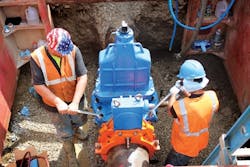Insertion Valve Keeps Municipality On Time & Under Budget
The village of Lombard, Ill., was in the middle of a major project to add improved water service to an important commercial and residential area. With pipeline extensions well under way, the village planners needed to prepare for the joining of the new components with the existing system.
A section of 16-in. water main was chosen as the best location for a valve that would enable a successful connection of the completed additions. The municipal team reviewed its options and listed important concerns: The desired site was near the intersection of two major and heavily travelled roads; any excavation was required, if possible, to avoid encroaching on the roadways. Interruption of service within the densely populated area should be minimized, if not totally avoided. Restraint problems (e.g., framing and concrete work) for a severed line could be both expensive and expansive, demanding a larger work area that would create environmental and traffic problems. Coordination of a lengthy installation had the potential to run up costs and also impact the timing of project phases.
Step 1: Valve Selection
After a review of available options, EZ Valve from Advanced Valve Technologies was chosen because it provides all the desired features, offers a 16-in. model, is factory pressure tested, meets UL listing and AWWA material specs, and is certified to NSF/ANSI Standard 61, among other cost-saving benefits. The selection of an insertion valve limited the system impact to only one pipe length as opposed to requiring upstream and downstream line stops to accomplish a standard valve installation.
Step 2: Site Preparation
Because the valve has a compact design, does not require oversized and supplemental isolation equipment, and utilizes an efficient milling operation, a single, smaller excavation was needed.
Step 3: Valve Installation
The installation proceeded in three phases. First, the pipe section was cleaned, lubricated and fitted with the valve body castings. A unique gasket system allows the assembled body to rotate on the pipe length and still maintain line pressure. Phase two addressed valve access to the pipe length while under full pressure. A universal milling machine was temporarily attached to the bonnet plate and then rotated to cut an access slot for the resilient wedge gate. This milling process makes a 3.5-in. slot over a 120-degree path while capturing the milled debris.
The final phase covered the attachment of the valve bonnet to the body and operation of the valve to confirm closure. Once the valve operation was cycled and tested, the body bolts were fully tightened and the locking bolts secured the valve body in final position.
The complete process maintains pipeline integrity throughout the install, which means complicated, time-consuming and costly restraint measures are not needed.
The Resolution
The new 16-in. valve was installed and confirmed to be working properly in less than six hours. It was installed under pressure with no service interruption. With the completion of the village’s water system expansion, the valve will contribute to a successful joining of the old with the new.
Water treatment such as chlorination or de-chlorination was not needed. Maintaining service meant there was no loss of fire protection. Public notification of shutdown activities was avoided. The valve delivered a drip-tight seal that performs even in heavily tuberculated pipe. Conservation of water, minimal earth removal and replacement, and reduced energy consumption combined to provide the project with a low environmental impact. Finally, the total installed cost was attractive when compared to larger multiple excavation options that require extensive tool kits, more heavy equipment usage and remedial restraint operations.
